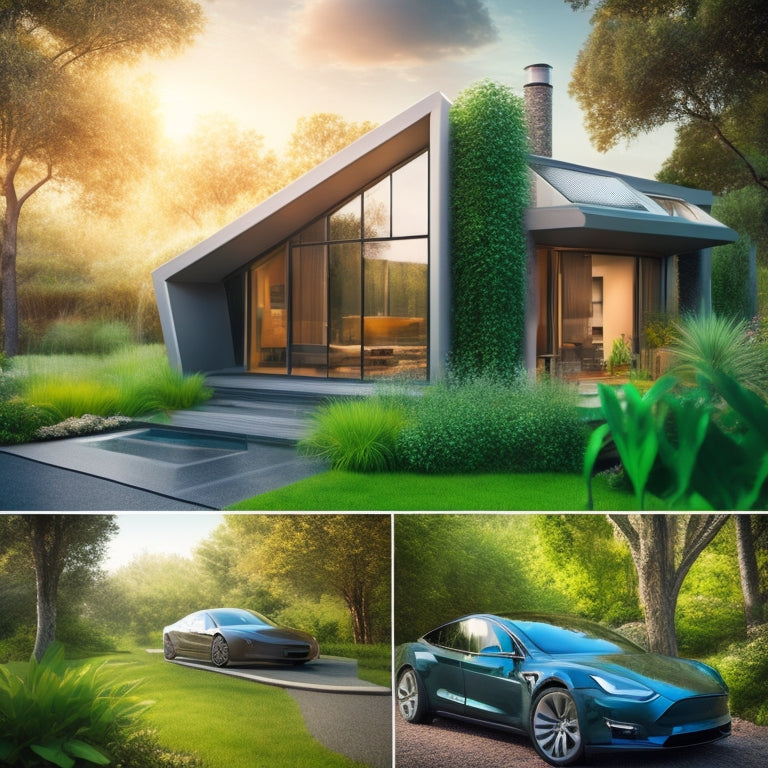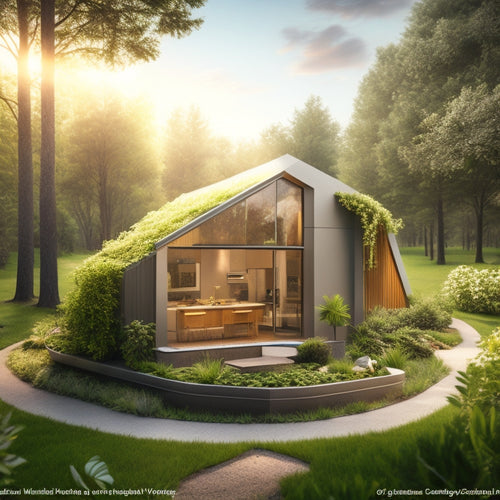
7 Green Home Innovations: From Toilets to Teslas
Share
You're looking to reduce your environmental footprint and upgrade to a greener home. From toilets to Teslas, inventive solutions can revolutionize your daily life. Composting toilets, for instance, conserve water and turn waste into fertilizer. Electric vehicles, like Teslas, offer sustainable commutes, while solar panels and smart home automation optimize energy usage. Water conservation systems, sustainable building materials, and green roof technology also provide significant eco-friendly benefits. As you investigate these state-of-the-art innovations, you'll reveal even more ways to change your home into a haven of sustainability, and uncover the exciting possibilities that await you.
Key Takeaways
- Composting toilets conserve water, reduce waste, and produce nutrient-rich fertilizer, offering an eco-friendly alternative to traditional toilets.
- Solar panels with advanced energy harvesting systems and high-efficiency cell technology increase energy generation in green homes.
- Electric vehicles, supported by expanding charging infrastructure and government incentives, offer a sustainable transportation option for eco-conscious homeowners.
- Green roofs with thermal mass provide natural insulation, manage stormwater, and promote biodiversity, enhancing the overall sustainability of a home.
- Rainwater harvesting and greywater recycling systems conserve water and reduce waste, making them essential components of a green home.
Composting Toilets Revolutionize Waste
You're likely familiar with traditional toilets that waste gallons of water with every flush, but composting toilets are changing the game by revolutionizing the way we think about waste.
These eco-friendly alternatives not only conserve water but also provide compost benefits, turning human waste into nutrient-rich fertilizer for your garden. Effective odor management is key to successful composting, and modern composting toilets have got it down to a science.
By reducing reliance on fossil fuels and lowering carbon footprint solar energy solutions, composting toilets also contribute to a cleaner environment.
With advanced ventilation systems and microbe-rich environments, these toilets minimize unpleasant smells and maximize the composting process.
Electric Vehicles for Eco-Friendly Commutes
One hundred years ago, electric vehicles (EVs) were a common sight on American roads, but they eventually lost out to gasoline-powered cars.
Today, you have the opportunity to join the EV revolution and make a significant impact on the environment. With advancements in battery technology, EVs are becoming more efficient and affordable.
Consider the following benefits of switching to an EV:
-
Reduced range anxiety: With the expansion of charging infrastructure, you can drive long distances without worrying about running out of power. In fact, the global charging station network supports convenient EV ownership, making it easier to find a charging station on the go Charging Infrastructure.
-
Eco-friendly materials: Many EVs are made with sustainable materials, reducing their carbon footprint even further.
-
Government incentives: You may be eligible for tax credits or rebates when purchasing an EV, which can help lower total ownership expenses.
- Seamless integration with urban planning: EVs can be easily integrated into ride-sharing programs and electric bike networks, making your commute more efficient and environmentally friendly.
Solar Panels for Renewable Energy
You're likely aware that solar panels are a key component of green homes, but you mightn't know about the advanced energy harvesting systems that maximize their output.
These systems optimize panel angle, cleaning, and monitoring to guarantee you're getting the most energy from the sun. For instance, the orientation and tilt angles of solar panels can greatly impact energy production efficiency, which can be optimized based on geographic location and climate.
High-efficiency cell technology has notably increased the amount of energy you can generate per panel, making solar power a more viable option for your home.
Energy Harvesting Systems
By integrating energy harvesting systems into your home, you can considerably reduce your reliance on non-renewable energy sources and lower your carbon footprint.
These systems convert ambient energy into usable power, giving you more control over your energy usage. For instance, businesses can also benefit from energy harvesting systems, such as installing solar-powered EV charging stations to minimize their carbon footprint and operating costs.
Additionally, this shift to renewable energy can attract environmentally conscious customers and increase property value.
Some innovative ways to utilize energy include:
- Piezoelectric flooring: captures kinetic energy from footsteps and converts it into electrical energy.
- Solar windows: generates energy while still allowing light to pass through.
- Wind turbines: converts wind energy into power for your home.
- Thermoelectric systems: recovers energy from waste heat, reducing energy loss.
High-Efficiency Cell Technology
Your home's change to renewable energy is further supported by high-efficiency cell technology, which greatly enhances the energy output of solar panels. This advanced innovation allows you to generate more power from the same amount of sunlight, making your move to green energy even more efficient.
High-density cells are at the heart of this technology, packing more power into smaller spaces to increase solar efficiency. By utilizing renewable energy solutions like solar power, you can reduce your reliance on fossil fuels and lower your carbon footprint.
With high-efficiency cell technology, you can enjoy a faster return on investment and a reduced carbon footprint. By capturing the power of the sun more effectively, you're taking a significant step towards energy independence and a more sustainable future.
Smart Home Automation for Efficiency
In pursuit of a greener tomorrow, homeowners are turning to smart home automation to maximize energy efficiency and reduce their carbon footprint. By integrating automated systems, you can optimize your home's energy usage and enjoy a more sustainable lifestyle.
Here are some ways smart home automation can enhance efficiency:
-
Smart thermostat integration: Regulate your home's temperature with precision, ensuring you use only the energy you need.
-
Automated lighting systems: Dim or turn off lights automatically when not in use, reducing energy waste.
-
Optimized appliance scheduling: Schedule your appliances to run during off-peak hours, reducing strain on the grid.
- Real-time energy monitoring: Track your energy usage in real-time, identifying areas for improvement.
With smart home automation, you're in control of your energy consumption, freeing you to live a more sustainable, eco-friendly life.
Energy-Efficient Water Conservation Systems
Nearly 40% of an average household's water usage goes towards flushing toilets, taking showers, and running faucets. You can greatly reduce this amount by installing energy-efficient water conservation systems.
One innovative approach is rainwater harvesting, which collects and stores rainwater for non-potable uses like flushing toilets and washing cars. Another method is greywater recycling, which reuses water from sinks, showers, and washing machines for irrigation and flushing toilets.
By implementing these systems, you'll not only reduce your water bill but also decrease your environmental footprint. Plus, many governments offer incentives for homeowners who adopt water-conserving measures, so you may be eligible for rebates or tax credits.
Start exploring these options to make your home more water-efficient and eco-friendly.
Sustainable Building Materials for Homes
The construction of your dream home can have a significant impact on the environment, and one essential aspect to evaluate is the type of building materials used.
You have the power to make a positive change by choosing sustainable materials that reduce waste and conserve natural resources.
Consider these eco-friendly options:
- Reclaimed wood and recycled materials for reducing waste and preserving natural resources.
- Bamboo flooring for a durable and renewable alternative to traditional hardwood.
- Natural insulation and low VOC adhesives for a healthier indoor environment.
- Eco-friendly paint and non-toxic finishes for a safer and more sustainable space.
Green Roof Technology for Insulation
You're likely familiar with the concept of green roofs, but did you know they can also provide significant insulation benefits?
By incorporating thermal mass into your green roof design, you can reduce heat loss in the winter and heat gain in the summer.
When selecting plants for your green roof, it's crucial to choose species that thrive in your local climate and can withstand the rooftop conditions.
Thermal Mass Benefits
Building on the principles of green roof technology, thermal mass benefits emerge as a key aspect of insulation, offering a unique solution for regulating indoor climates.
By incorporating thermal mass into your home's design, you can enjoy a more comfortable and consistent indoor temperature. This is achieved through thermal storage, where materials absorb and release heat as needed, providing passive heating and cooling.
Here are some benefits you can expect from thermal mass:
-
Reduced energy consumption: By regulating indoor temperatures naturally, you'll rely less on HVAC systems.
-
Improved air quality: Thermal mass helps remove pollutants and excess moisture from the air.
-
Increased durability: Thermal mass materials can last for decades with minimal maintenance.
- Enhanced comfort: Enjoy a more consistent and comfortable indoor climate, no matter the season.
Plant Selection Matters
As you incorporate thermal mass into your home's design, another essential component of green roof technology comes into play: plant selection. Choosing the right plants can enhance your home's insulation, air purification, and overall aesthetic appeal. Consider native species that require minimal maintenance and are drought-resistant.
| Plant Feature | Benefits |
|---|---|
| Seasonal Blooms | Attracts pollinators, adds color to your outdoor space |
| Low Maintenance | Reduces upkeep, conserves water and energy |
| Edible Landscaping | Provides fresh produce, increases food security |
Frequently Asked Questions
Can I Install Green Home Innovations Myself or Do I Need a Professional?
You can try DIY installation, but it's recommended you get a professional assessment first, especially for complex innovations like solar panels or electric vehicle charging stations, to guarantee a safe and efficient setup.
How Do I Measure the Environmental Impact of My Green Home Upgrades?
You'll want to conduct a carbon footprint assessment to measure the environmental impact of your green home upgrades, considering factors like energy savings and sustainable material choices, to gauge the effectiveness of your eco-friendly investments.
Are There Government Incentives for Green Home Innovations and Upgrades?
You're likely eligible for federal tax credits and state rebates when investing in green home innovations; research these incentives to maximize your savings and offset upgrade costs, allowing you to live more sustainably without breaking the bank.
Can I Integrate Green Home Innovations Into an Existing Home?
You can retrofit your existing home like a skilled puzzle solver, seamlessly integrating green innovations like energy-efficient appliances and sustainable landscaping, giving you the freedom to reduce your carbon footprint and save on utility bills.
Do Green Home Innovations Increase the Resale Value of My Property?
You'll be happy to know that investing in eco-friendly renovations can enhance your green valuation, increasing your property's resale value as buyers seek sustainable living options, giving you a competitive edge in the market.
Related Posts
-

How to Upgrade Your Home With Geothermal Innovations
You're now on the cusp of utilizing the Earth's natural thermal energy to revolutionize your home's heating and cooli...
-

7 Best Automated Sprinklers for Water-Wise Green Homes
You're likely among the 75% of U.S. homeowners who use in-ground sprinkler systems, and coincidentally, you're also c...
-

10 Best Sustainable Waste Management Solutions for Green Homes
You're likely unaware that the average green home generates over 2 kilograms of waste daily, but with the right susta...


